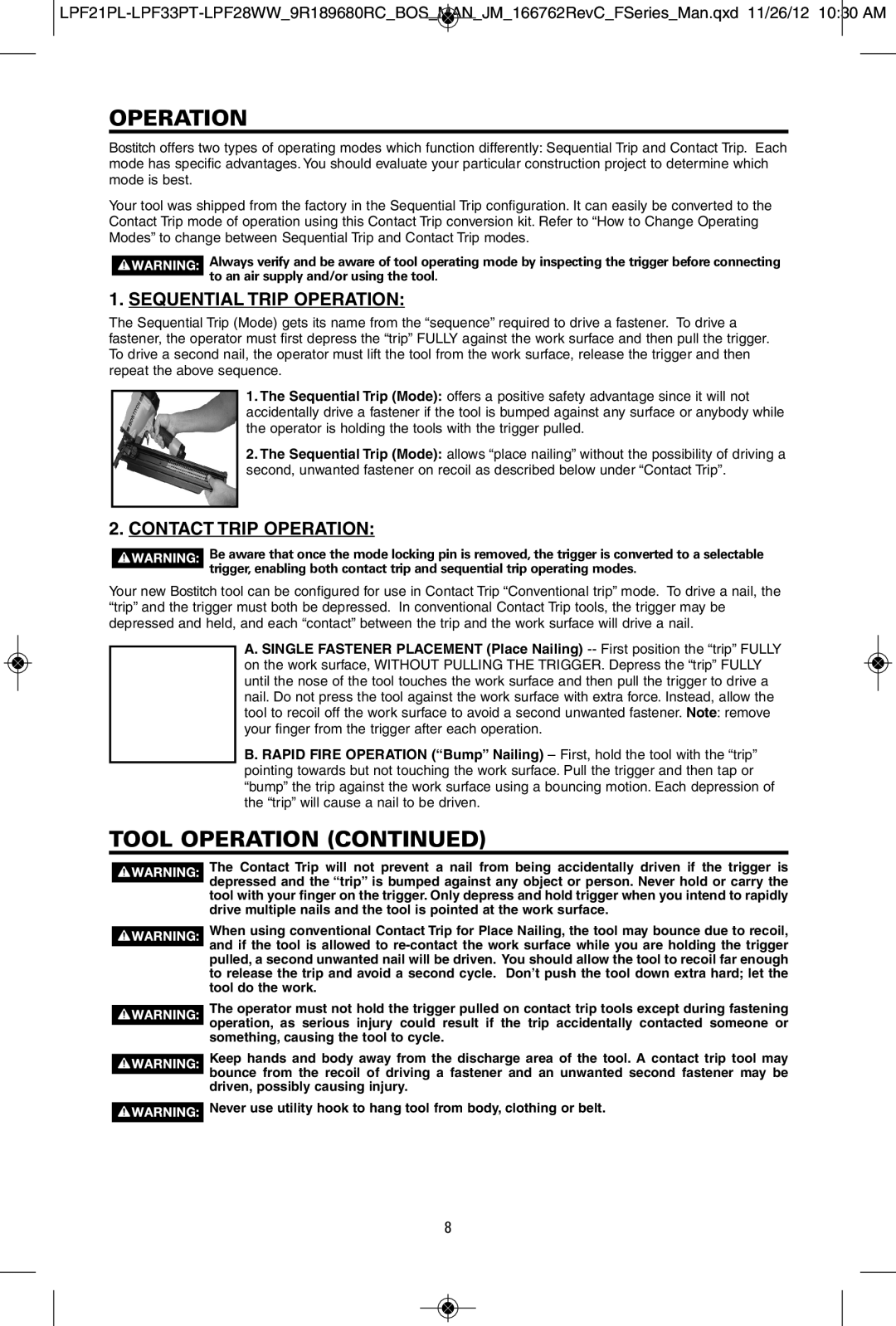
![]()
OPERATION
Bostitch offers two types of operating modes which function differently: Sequential Trip and Contact Trip. Each mode has specific advantages. You should evaluate your particular construction project to determine which mode is best.
Your tool was shipped from the factory in the Sequential Trip configuration. It can easily be converted to the Contact Trip mode of operation using this Contact Trip conversion kit. Refer to “How to Change Operating Modes” to change between Sequential Trip and Contact Trip modes.
Always verify and be aware of tool operating mode by inspecting the trigger before connecting to an air supply and/or using the tool.
1.SEQUENTIAL TRIP OPERATION:
The Sequential Trip (Mode) gets its name from the “sequence” required to drive a fastener. To drive a fastener, the operator must first depress the “trip” FULLY against the work surface and then pull the trigger. To drive a second nail, the operator must lift the tool from the work surface, release the trigger and then repeat the above sequence.
1.The Sequential Trip (Mode): offers a positive safety advantage since it will not accidentally drive a fastener if the tool is bumped against any surface or anybody while the operator is holding the tools with the trigger pulled.
2.The Sequential Trip (Mode): allows “place nailing” without the possibility of driving a second, unwanted fastener on recoil as described below under “Contact Trip”.
2.CONTACT TRIP OPERATION:
Be aware that once the mode locking pin is removed, the trigger is converted to a selectable trigger, enabling both contact trip and sequential trip operating modes.
Your new Bostitch tool can be configured for use in Contact Trip “Conventional trip” mode. To drive a nail, the “trip” and the trigger must both be depressed. In conventional Contact Trip tools, the trigger may be depressed and held, and each “contact” between the trip and the work surface will drive a nail.
A. SINGLE FASTENER PLACEMENT (Place Nailing)
B. RAPID FIRE OPERATION (“Bump” Nailing) – First, hold the tool with the “trip” pointing towards but not touching the work surface. Pull the trigger and then tap or “bump” the trip against the work surface using a bouncing motion. Each depression of the “trip” will cause a nail to be driven.
TOOL OPERATION (CONTINUED)
The Contact Trip will not prevent a nail from being accidentally driven if the trigger is depressed and the “trip” is bumped against any object or person. Never hold or carry the tool with your finger on the trigger. Only depress and hold trigger when you intend to rapidly drive multiple nails and the tool is pointed at the work surface.
When using conventional Contact Trip for Place Nailing, the tool may bounce due to recoil, and if the tool is allowed to
The operator must not hold the trigger pulled on contact trip tools except during fastening operation, as serious injury could result if the trip accidentally contacted someone or something, causing the tool to cycle.
Keep hands and body away from the discharge area of the tool. A contact trip tool may bounce from the recoil of driving a fastener and an unwanted second fastener may be driven, possibly causing injury.
![]() Never use utility hook to hang tool from body, clothing or belt.
Never use utility hook to hang tool from body, clothing or belt.
8
